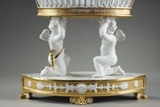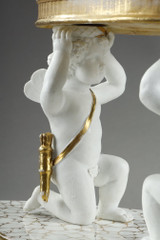A very large, shuttle-shaped basket in openwork white porcelain, highlighted with gold, resting on two kneeling Erotes carrying their quivers, on a base of the same shape and supported by claw or lion's paw feet. The oblong base is decorated on both sides with a mask in a central medallion and a foliate motif ending in palmettes. It is a piece of what is known as Paris porcelain. Circa 1830.
What is Paris Porcelain?
The history of Parisian porcelain began late in the 18th century, in the 1770s, when Limousin kaolin was commercialized and the monopoly on porcelain production that protected the royal Sèvres manufactory was broken. The French Revolution contributed to the proliferation of factories, now definitively freed from Sèvres' monopoly. These factories, however, mostly had only a brief existence. They suffered from the economic crises stemming from the Napoleonic Wars. Despite these difficulties, the Parisian porcelain makers reached their peak in the 1820s. Subsequently, their numbers steadily declined, as the hope of making large sums of money from porcelain production proved dashed. This led to the closure of factories or their relocation to the provinces. Therefore, it is consistent to call Paris porcelain the hard-paste porcelains, unmarked but dating in style from the first part of the 19th century.
Condition report: Losses and wear to the gilding, particularly on the base of the basket. Otherwise, good overall condition. Restoration of one of the quivers at the bottom and of the fingertips of one of the cupids.
- Reference :
- 3338
- Width :
- 45 (cm)
- Height :
- 35 (cm)
- Depth :
- 30 (cm)
- Era:
- 19th century
- Materials:
- Porcelain
















































